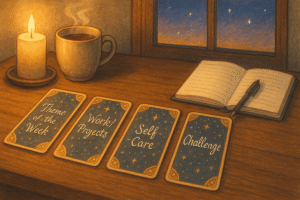Table of Contents
When I first started reading tarot, I relied heavily on traditional spreads like the Celtic Cross or simple three-card layouts. They served me well, but something always felt slightly off. The questions I wanted to explore didn’t quite fit the predetermined positions, and I found myself forcing interpretations to match the spread rather than letting the cards speak naturally to my situation.
That’s when I discovered the power of creating my own tarot spreads. It was like finding the perfect key for a lock I’d been struggling with. Suddenly, my readings became more focused, more personal, and infinitely more meaningful. The process of designing a spread specifically for your question transforms tarot from a generic fortune-telling tool into a deeply personal mirror for self-reflection.
Creating your own tarot spread isn’t about rejecting traditional methods. Rather, it’s about expanding your toolkit and developing a more intimate relationship with the cards. When you design a spread yourself, you’re actively engaging with your question before you even draw the first card. This preparation creates a sacred space for contemplation that enhances the entire reading experience.
Understanding the Purpose Behind Spread Creation
Before diving into the mechanics of spread design, it’s worth considering why custom spreads can be so powerful. Traditional spreads are wonderful, but they were created by other people to address their questions and perspectives. When you create your own spread, you’re honoring your unique way of thinking about problems and situations.
Think about how your mind naturally organizes information when you’re pondering a complex issue. Some people think linearly, moving from past to present to future. Others prefer to examine all aspects of a situation simultaneously, like pieces of a puzzle. Some focus on emotions first, then practical considerations, while others approach things from a more analytical angle.
Your custom spread can mirror your natural thought processes, making the reading feel more intuitive and relevant. I’ve found that spreads I create myself often reveal insights I might have missed with a traditional layout, simply because they’re asking the questions I actually want answered, in the order that makes sense to my particular situation.
Defining Your Question or Goal
The foundation of any effective tarot spread lies in having a clear, well-defined question or goal. This might sound simple, but it’s often the step that requires the most thought and refinement. Vague questions lead to vague spreads, which produce muddy readings that leave you more confused than enlightened.
Start by writing down your initial question, whatever it may be. Don’t worry about making it perfect right away. Let’s say you’re facing a career transition and your first attempt might be something broad like “What should I do about my job?” This is a starting point, but it needs more focus.
Ask yourself what specifically you want to understand about this situation. Are you wondering about timing? Are you torn between staying safe and taking a risk? Do you need clarity about your motivations, or are you more concerned about potential obstacles? Perhaps you’re questioning whether this change aligns with your deeper values.
Spend some time with your question. Write it, rewrite it, sleep on it. Sometimes the real question hiding beneath the surface takes a day or two to emerge. I remember working on a spread about a relationship issue, thinking I wanted to know whether to stay or go. After several days of reflection, I realized my actual question was about learning to communicate my needs more effectively. The spread I eventually created was far more useful than anything addressing the stay-or-go dilemma would have been.
Brainstorming Key Aspects of Your Situation
Once you have a clear central question, it’s time to break it down into smaller, manageable components. This is where you identify all the different angles and perspectives that contribute to your overall situation. Think of it as mapping the landscape of your question.
I find it helpful to start with a brain dump. Write down everything that comes to mind related to your central question, without worrying about organization or importance. Include emotions, practical considerations, other people involved, potential outcomes, fears, hopes, and any other elements that feel relevant.
For that career transition question, your brainstorm might include items like current job satisfaction, financial security, family considerations, personal growth opportunities, market conditions, your skills and qualifications, timing concerns, and what success would look like to you.
Don’t rush this process. Sometimes the most important aspects are the ones that take a while to surface. You might initially focus on obvious external factors and only later realize that your relationship with risk or your family’s expectations are equally crucial to consider.
Once you have your comprehensive list, start grouping related items together. You might notice themes emerging, like “internal factors” and “external circumstances,” or “immediate concerns” and “long-term implications.” These natural groupings will often suggest the structure for your spread.
Assigning Aspects to Card Positions
This is where your spread starts to take concrete shape. Each major aspect or group of aspects from your brainstorm becomes a position in your spread, and each position gets assigned a specific question or focus area.
The key is to be specific about what each position represents. Instead of a vague position like “obstacles,” try something more precise like “What internal resistance am I carrying about this change?” or “What external challenges should I prepare for?” The more specific your position descriptions, the more targeted and useful your reading will be.
Consider the logical flow between positions as well. You might want to start with understanding the current situation, move through various contributing factors, and end with potential outcomes or advice. Or perhaps you prefer to examine the situation from different stakeholder perspectives. There’s no single right way to organize positions, but there should be some coherent logic to their sequence.
I typically aim for somewhere between five and ten positions for a custom spread. Fewer than five often doesn’t provide enough depth, while more than ten can become overwhelming and difficult to synthesize. Though honestly, I’ve created effective three-card spreads and elaborate fifteen-card layouts, depending on the complexity of the question.
Write out each position clearly, perhaps numbering them in the order you plan to lay out the cards. For example: “Position 1: What is the core of my current dissatisfaction? Position 2: What opportunities am I not seeing? Position 3: What would I need to sacrifice for this change?” and so on.
Choosing a Meaningful Layout Shape
The physical arrangement of your cards can add another layer of meaning to your spread. While you could certainly lay cards out in a simple line or grid, choosing a shape that resonates with your question can enhance the reading experience.
Some shapes carry inherent symbolism that might align with your situation. A circular arrangement suggests cycles, completion, or wholeness. A cross shape might represent crossroads, balance, or the intersection of different forces. A spiral could indicate growth, evolution, or gradual unfolding. A triangle might suggest stability, hierarchy, or the interplay between three key elements.
Think about shapes that have personal meaning for you as well. If you’re drawn to star patterns, heart shapes, or even more abstract arrangements, trust that instinct. The goal is to create a layout that feels right for your question and helps you engage more deeply with the reading.
Consider the practical aspects too. Will you be able to see all the cards clearly in your chosen arrangement? Is there a logical flow from one position to the next that makes sense with your card placement? Sometimes I sketch out a few different options before settling on the final layout.
Don’t feel pressured to be overly creative with the shape. Sometimes a simple arrangement is exactly what serves the question best. The shape should enhance your reading, not distract from it or make it unnecessarily complicated.
Putting It All Together
Now comes the exciting part where you test your newly created spread. Gather your cards, create a quiet space for your reading, and lay out the positions according to your design. Take a moment to review what each position represents before you begin drawing cards.
As you work through the reading, pay attention to how well the spread serves your question. Do the positions feel relevant and meaningful? Is there a natural flow from one card to the next? Are you getting the kind of insights you hoped for when you designed the spread?
Don’t be surprised if you want to make adjustments after trying the spread once or twice. Maybe you realize you need an additional position to address something you overlooked, or perhaps two positions are redundant and could be combined. This fine-tuning is a normal part of the process.
Keep notes about spreads you create, especially the ones that work well. I have a small notebook where I record successful custom spreads, along with notes about what types of questions they work best for. Some spreads turn out to be one-time creations for very specific situations, while others become regular tools I return to whenever certain themes arise in my life.
Making Your Spreads Work for You
The beauty of custom spread creation is that it deepens your relationship with tarot beyond simply memorizing card meanings or following prescribed layouts. When you create your own spreads, you’re actively engaging with the process of inquiry itself. You’re learning to ask better questions, to think more systematically about complex situations, and to trust your own intuitive sense of what needs exploration.
Remember that creating tarot spreads is as much an art as it is a technique. Some spreads will feel immediately powerful and insightful, while others might fall flat despite your best efforts. This is completely normal and part of the learning process. Each attempt teaches you something about both spread design and your own patterns of thinking and questioning.
Consider sharing your successful spreads with others in the tarot community, whether through online forums, social media, or local groups. Often a spread created for one person’s specific situation resonates with others facing similar challenges. You might find that your custom creation becomes someone else’s go-to layout for certain types of questions.
The process of creating your own tarot spreads transforms you from a passive recipient of predetermined structures into an active participant in designing your own tools for self-discovery. It’s a practice that grows richer with time, as you develop a better understanding of both your own inquiry patterns and the subtle art of crafting questions that open doors to genuine insight.
What question is calling for your attention right now? What spread might you create to explore it more deeply? The cards are waiting, and the design is entirely up to you.
Frequently Asked Questions
How many card positions should I include in my custom spread?
Most tarot readers find their sweet spot between three to eight positions for custom spreads, though you can adjust based on your question’s complexity. Start with fewer positions if you’re new to creating spreads, as simpler layouts are often more powerful and easier to interpret. You can always add positions later if you feel something important is missing, but avoid making spreads unnecessarily complicated just for the sake of having more cards.
Can I modify a traditional spread instead of creating one from scratch?
Absolutely, and this is actually a great way to start building confidence with custom spreads. You can take a spread you’re already comfortable with and add or modify positions to better suit your specific question. For instance, if you’re using a three card spread but need clarification on one particular position, create a specific question for that extra card rather than just drawing it randomly. This helps you develop the skill of assigning meaningful positions, which is the foundation of spread creation.
What if my custom spread doesn’t work well the first time I use it?
This happens to everyone and it’s completely normal. You’ll usually discover some overlapping or unnecessary positions when you test a new spread, so don’t hesitate to edit and refine it. Sometimes positions that seemed important during planning turn out to be redundant, or you realize you need an additional position to address something you overlooked. Keep notes about what worked and what didn’t, then adjust the spread accordingly for next time.
Do I need to use a special shape or can I just lay cards in a line?
Many readers simply lay cards out one after another in a linear fashion, and that works perfectly fine. While symbolic shapes like circles, crosses, or stars can add extra meaning to your reading, they’re not necessary for an effective spread. Choose whatever layout helps you see the relationships between cards most clearly. The content of your questions matters far more than the visual arrangement, so prioritize clarity and readability over creative shapes.







